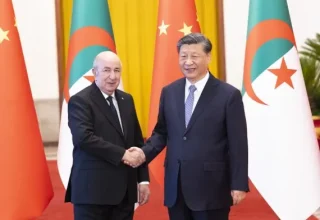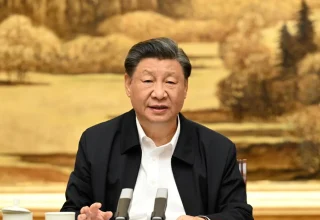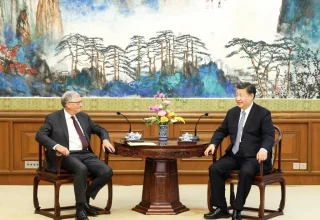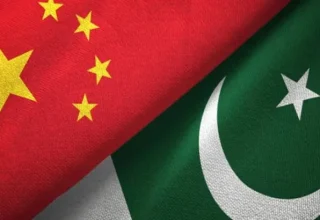
Right from the beginning China’s neighborhood foreign policy has been standing for mutual sovereignty, territorial integrity, peaceful co-existence, international cooperation, economic globalization, immense regionalism through socio-economic integration, free trade, connectivity and above all political consultation, dialogue, diplomacy and development. Moreover, regional peace, prosperity, stability and harmony have been the cornerstones of its pragmatic foreign policy.
It seems that China has been showing a strong commitment to achieve and maintain the path of peaceful development through openness, inclusiveness and modernization which has been instrumental to jointly build a community with a shared future among neighboring countries.
Fortunately, because of China’s drastic economic rise, Asia has succeeded to double its share in the global economy in the last four decades. It has now become an important engine and driving force of the global economic recovery and growth (50 percent). It has the biggest development potential in the world and will hopefully remain a promising land for global development and prosperity.
However, unfortunately due to Cold war mentality, unilateralism, protectionism and hegemonism and potential global risks of energy, food, finance, industrial and supply chains and climate change are trying to dysfunctional global governance. It is also creating problems for Asia. Nevertheless, China’s neighborhood foreign policy has been mitigating all spillover repercussions.
Furthermore, increasing military euphoria in the region, Korean Peninsula and Afghanistan issue faces numerous challenges in its reconstruction; terrorism, natural disasters and other non-traditional security threats persist which needs to be resolved through dialogue and diplomacy and Chinese wise diplomacy is achieving diplomatic miracles in this regard.
Interestingly, two divergent forces are trying for complete dominance. One advocates open regionalism, true multilateralism, a development-first approach, mutually beneficial cooperation, openness and inclusiveness, integrated development, and pursuit of common development in harmony. The other highlights a relapse into the Cold War mentality and exclusive clubs, and attempts to draw lines based on values, politicize economic issues, divide the region into different security blocs, and stoke division and confrontation.
Notwithstanding, in this complex and complicated socio-economic, geopolitical and geostrategic scenarios the Chinese wisdom rightly stands for openness, solidarity, cooperation, justice and harmony rather than isolation, division, confrontation, hegemony and zero-sum approach in Asia which should be appreciated.
In addition to this, it is good omen that China and its neighbor countries have jointly advocated the “Five Principles of Peaceful Coexistence”, carried forward the “Bandung Spirit of solidarity”, friendship and cooperation, and kept advancing good-neighborliness and mutually beneficial cooperation. To achieve this goal China has established diverse and substantive partnerships, cooperative relations and strategic relations of mutual benefit with 28 neighboring countries and ASEAN.
Moreover, it has been pursued a holistic policy of the global development with shared community development with Lancang-Mekong and Central Asian countries. Through resolving historical boundary issues with 12 neighbors, and signing and ratifying the Protocol to the Treaty on a Nuclear-Weapon-Free Zone in Central Asia, China has succeeded to promote peaceful co-existence and development in Asia.
Despite western false and fake propaganda, China became the first to join the Treaty of Amity and Cooperation in Southeast Asia and is fully prepared to sign the Protocol to the Southeast Asia Nuclear-Weapon-Free Zone Treaty at any time. Thus Pentagon’s annual report of Chinese armaments and arsenals does not have any creditability and relevance.
In terms of trade & commerce and socio-economic integration, China is the largest trading partner of 18 neighboring countries. According to the Chinese official data, in 2022, China’s trade in goods with neighboring countries exceeded USD 2.17 trillion, up by 78 percent from 2012. The two-way investment between China and ASEAN has exceeded USD 380 billion in cumulative terms.
China took the lead in ratifying the Regional Comprehensive Economic Partnership (RCEP) and worked for its entry into force and implementation, enabling and enhancing regional economic integration. Thus China has been the magnetic force for free trade and immense socio-economic integration in Asia.
The Chinese BRI has also delivered benefits to the neighborhood. It promoted spirits of mutual befitting propositions, philosophy of open, green and clean cooperation through high-standard, sustainable and people-centered cooperation.
In this regard, China has signed Belt and Road cooperation documents with 24 neighboring countries and worked to synergize the BRI with cooperation plans of ASEAN and the Eurasian Economic Union.
Through the establishment of the Asian Infrastructure Investment Bank and the Silk Road Fund China has provided financial support for infrastructure projects. Resultantly, a general connectivity framework consisting of six corridors, six connectivity routes and multiple countries and ports has been put in place.
China’s foreign policy supports security, development and regional connectivity. It co-funding of the SCO and the China-Central Asia mechanism established has emerged as an important platform for in-depth cooperation between the six countries. Lancang-Mekong Cooperation is a success story of mutually beneficial cooperation in the sub-region.
Furthermore, the ASEAN-centered East Asia cooperation mechanism, China-Japan-ROK cooperation, and Asia-Pacific Economic Cooperation (APEC) have immensely contributed to the region’s integrated development and people’s well-being.
For achieving the regional peace, stability and harmony, China has suggested workable suspension-for-suspension, dual-track approach and political settlement for settling issue of Korean Peninsula. In case of Afghanistan it re-launched mechanism of the China-Afghanistan-Pakistan Foreign Ministers’ Dialogue, and issued the Tunxi Initiative for its reconstruction and development, building synergy among various parties. It has encouraged all the parties to bridge differences, restore social stability in the country in case of Myanmar.
China’s role in tackling challenges of terrorism, separatism, financial crisis and COVID-19 in regional countries is also remarkable.
In summary, China’s pragmatic foreign policy of neighborhood guarantees regional peace, prosperity and stability. It facilitates dreams of greater regional connectivity through BRI and other befitting propositions & projects. It fosters peaceful co-existence through the vision of common, comprehensive, cooperative and sustainable security system all the regional countries of Asia and around the globe.
China promotes constructive regionalism and productive economic globalization and just geopolitical system through rejecting the Cold War mentality, unilateralism, group politics and bloc confrontation.
Hopefully, through firmly China’s pledging to uphold the international system with the United Nations at its core it will achieve a just international order and promote international law based governance on the principles of the UN Charter. Thus China encourages Asia’s tradition of solidarity and mutual assistance.
Taiwan has been the integral part/province of the mainland China for centuries. China has the legitimate rights of national reunification and firmly opposes “Taiwan independence”.
China will never seek hegemony or expansion and will effectively implement the Declaration on the Conduct of Parties in the South China Sea (DOC) and actively advance consultations and conclusion of a Code of Conduct in the South China Sea (COC), and work with parties concerned in the South China Sea to properly address maritime disagreements and differences through dialogue. Therefore it will promote spirits of peaceful conflict resolution through dialogue, diplomacy and development.
China will continue to promote the process of joining the Comprehensive and Progressive Agreement for Trans-Pacific Partnership (CPTPP) and the Digital Economy Partnership Agreement (DEPA) thus it will continuously jointly work for further economic integration, digitalization and modernization.
To promote high-quality Belt and Road cooperation, China will give priority to connectivity corridor projects of railways and highways with neighboring countries, and accelerate the development of the New International Land-Sea Trade Corridor in the days to come.
It seems that further development of green energy cooperation and green growth model will drive economic growth through innovation, transform and upgrade economic, energy and industrial structures, and strike a fine balance between emission reduction and economic growth, in Asia.
China will further expand people-to-people exchanges and cooperation in the region, and cement popular support for good-neighborliness. Definitely it will rely on the four pillars of connectivity, development, security and people-to-people exchanges and will focus on the six cooperation areas of the political sector, economy and trade, science and technology, security, people-to-people exchanges and global challenges, work for a community with a shared future among neighboring countries that features shared concepts, plans, benefits, security and responsibilities.
China pledges to build Global Development Initiative pilot zone featuring more equitable, balanced and inclusive development partnership, Global Security Initiative pilot zone featuring an Asian pathway of security defined by planning together, building together and benefiting together, and Global Civilization Initiative pilot zone that boosts people-to-people exchanges and the mutual learning, harmonious coexistence of civilizations.
China will take an active part in East Asia cooperation, China-Central Asia mechanism, SCO, BRICS, APEC, Conference on Interaction and Confidence Building Measures in Asia (CICA) and other multilateral mechanisms and organizations, and strengthen dialogue and cooperation with the Pacific Islands Forum, Indian Ocean Rim Association and other regional organizations, in a bid to jointly promote the connectivity, stability and development of Asia, Pacific Ocean and Indian Ocean regions.
It is suggested that China and the United States should work jointly and promote spirits of mutual respect, peaceful coexistence and win-win cooperation in the Asia-Pacific and contribute positive energy to regional stability and development.



































